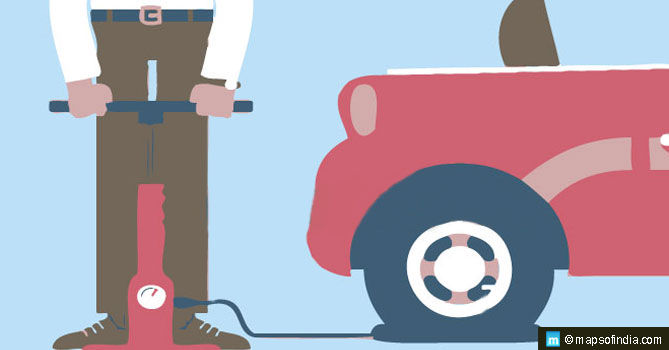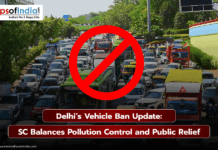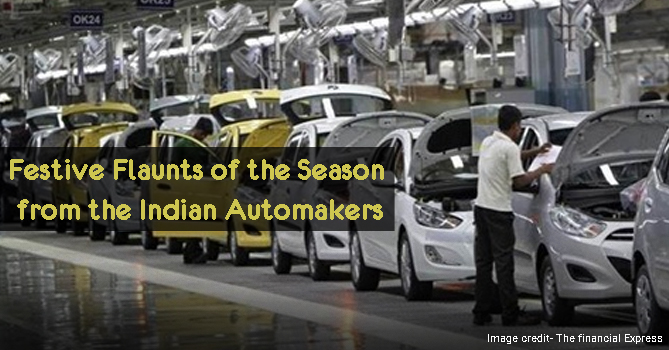
Tyres and air pressure
Driving and Handling a vehicle depends on a lot of parameters, the simplest of which is monitoring and maintaining the air pressure in tyres. This is vital to keeping tyre-wear as slow and gradual, as possible. Tyre-treads are the only thing bearing the load of the car and that of the road-friction simultaneously. They have certain manufacturer standards and guidelines to be followed in order to restrict wear to a minimum and increase their longevity. Excessive or low air pressure in tyres causes uneven contact with the road, which leads to uneven tyre wear. Uneven tyres cause improper load distribution which can lead to anything from premature suspension wear to complete tyre failure. Complete tyre failure can be risky, particularly in the case of a blow-out, wherein the vehicle can completely lose control and pose a danger to its occupants as well as others on the road.
Keep an eye out on the tyres every once in a while, in order to ensure they are all evenly filled with air. The contact area of the tread-face with the ground defines the amount of air inside them. If the air pressure is low, tyres would tend to squat and appear to be flatter at their respective points-of-contact, causing a sluggish, heavy driving experience. Tyres with extra air tend to have smaller areas in contact with the ground and cause a very light-footed, low-friction drive which can be dangerous while making sharp turns and applying brakes. Due to the reduced friction, over-inflated tyres tend to skid upon intense braking, the sharp turning of the steering, and acceleration.
The ideal tyre pressure of any vehicle is given at the base of its driver’s door pillar between the front and rear passenger doors, on the driver’s side. Commonly, the ideal air-pressure for passenger vehicles ranges between twenty-five and thirty pounds of load per square inch (psi) for factory specification tyres. In the case of customized or upsized wheels and tyres, the air pressure will depend on their respective load requirements, as guided by their dealer. The ideal air-pressure for any wheel-tyre combination can also be looked up online, in case of need.
Like almost all matter, regular compressed air is also prone to physical changes under heat and pressure. High temperatures due to friction and environmental interferences, cause the air inside tyres to expand, thereby increasing the internal pressure. In cold climate, the air molecules tend to huddle together, thereby compressing it further and decreasing the outward pressure inside the tyres, causing them to “flatten” a little.
For regions with diverse climates, and cars that are driven in sporting events, regular air does not suffice. Nitrogen is the best-approved gas to be filled in tyres across the automotive world. Motorsport events and premium car manufacturers, all choose Nitrogen over a regular day because of its longevity as compared to air in terms of temperature and pressure changes. This also makes Nitrogen ten times costlier than having regular air filled into the tyres, something that can also be done for free at most fuel pumps.
One should also get tyres checked for irregular wear, punctures, cuts, bubbles or grazes that might’ve occurred with usage. Bubbles are generally found to be an eligible cause for under-warranty replacement of tyres and should be reported to the dealer or purchase-point well in time. In the case of uneven wear, it is also important to get the wheel-alignment and weight-balance checked.
Lights
Next thing to be observed are the parking lights, headlights, taillights, fog lamps, rear-reflectors, turn-indicators, and reverse-gear guidance lights. It is important to check all external lighting for function and form-retention. In case of a damaged light, the bulb function should be checked immediately, and if found dysfunctional, should be replaced and checked again. Lights are among the top safety features of any automobile as they are visual aids to moving traffic, particularly in the absence of natural light.
Glass panels and wipers
Check wiper-blades – the glass clearing rubber-strips that are in direct contact with the windshield, for any signs of wear. Worn-out wiper blades only smear more water, or dirt, and leave hard-to-remove marks on the otherwise high-clarity glass.
Body Line
Take a look at the body line and panels once in a while, to ensure that it is scratch and damage-free and the print quality is maintained. In the event of damage, get the respective panel repaired and painted at a professional outlet, in order to keep the overall visual quality intact. This helps secure a better resale amount on the external maintenance front.
Check all door-handles, locks, and key inserts for proper and systematic function. In case of central-locking, check if all locks equally responsive to the lock and unlock commands from the remote, or when the key is turned in the driver door lock. If any of the locks are slow, or sluggish in response, get it checked from a body-line specialist or if possible, an electrician.
It is important to perform a complete walk-around of our cars at least once a week, in order to ascertain the exterior well being of the car. While there is so much more to maintenance, these basic steps and others will create a significant impact on their longevity.
Related Links:
Simple Steps to Effective Car Care – Part 1
Top Aggregators and Application based Automotive Solution Businesses in India





